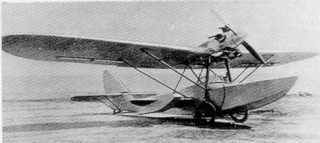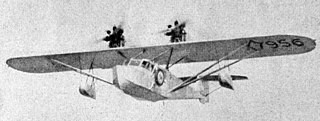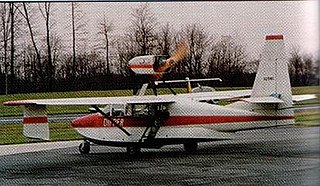Related Research Articles

The Buccaneer is a one- or two-seat ultralight high-wing amphibious flying boat of pusher configuration marketed as a kit aircraft.

The twin-engine F5L was one of the Felixstowe F series of flying boats developed by John Cyril Porte at the Seaplane Experimental Station, Felixstowe, England, during the First World War for production in America.

The Shavrov Sh-2 was a 1930s Soviet amphibious sesquiplane flying boat developed from the Sh-1, with a more powerful engine, slightly increased size and amphibious undercarriage. The Sh-2 could carry three people including the crew.

The Felixstowe F.5 was a British First World War flying boat designed by Lieutenant Commander John Cyril Porte RN of the Seaplane Experimental Station, Felixstowe.
The Fokker B.I was a reconnaissance flying boat built in the Netherlands in 1922. The B.I was followed by an improved version, the B.III in 1926. It was a conventional biplane flying boat design, with staggered sesquiplane wings braced by struts arranged as a Warren truss. The engine was mounted pusher-wise on the top wing. The duralumin hull featured three open cockpits - one at the nose for a gunner, one in front of the lower wing for the pilot and engineer and one behind the wings for another gunner. The B.I was amphibious, equipped with main undercarriage that folded back along the hull, but this feature was omitted in the B.III. The B.I was flown in the Dutch East Indies by the Naval Air Service for a number of years, and although it gave good service, no further examples were ordered from Fokker.

The Aeromarine AM-1 was a biplane built to pursue a US Air Mail Service requirement for a nighttime transport.
The Aeromarine BM-1 was a new mail plane design to meet a request for proposal by the US Postal Service in the 1920s.

The Towle WC, aka Towle TA-1, was a custom built aircraft for a 1929 round-the world flight.
The Towle TA-2 was an amphibious aircraft based on the T owle WC built for a 1929 round-the world flight.
The Diehl AeroNautical XTC Hydrolight is an American amphibious flying boat ultralight aircraft that was designed and produced by Diehl AeroNautical in the 1980s. The prototype first flew in March 1982, with production of kits commencing the following year.

The Aeromarine 50, also called the Limousine Flying Boat, was a luxury seaplane.
The World Seair Corp Seair is an American ultralight trike flying boat that was designed and produced by World Seair Corporation. The aircraft was supplied as a completed, read-to-fly aircraft and introduced in July 1998.
The Personal Flight Sky-Tender is an American ultralight trike flying boat that was designed and produced by Personal Flight of Chelan, Washington. Production is complete and the aircraft is no longer available.
The Aeromarine EO was a light sport flying boat that was built in the mid-1920s.
The Aeromarine Model 60 is a twin engine seaplane design from the Aeromarine aircraft company.

The Polaris AM-FIB is an Italian amphibious flying boat ultralight trike, that was designed and produced by Polaris Motor of Gubbio. The aircraft was introduced in 2003 and was supplied as a complete ready-to-fly-aircraft.

The Polaris FIB is an Italian flying boat ultralight trike, that was designed and produced by Polaris Motor of Gubbio. The aircraft was introduced in the mid-1980s and remained in production until about 2014. It was supplied as a complete ready-to-fly-aircraft.
The Adventure Air Adventurer is a family of American homebuilt amphibious flying boats that was designed and produced by Adventure Air of Berryville, Arkansas. When it was available the aircraft was supplied as a kit for amateur construction. The company appears to be out of business.

The Collins Dipper was an American homebuilt flying boat that was designed and produced by Collins Aero of Chadds Ford, Pennsylvania and first flown in 1982. The aircraft was supplied in the form of plans for amateur construction. Only one was built and none remain registered.
The Sunward STB is a Chinese amphibious ultralight trike, designed and produced by Sunward Tech of Zhuzhou. The aircraft is supplied complete and ready-to-fly.
References
- ↑ "Aeromarine Website" . Retrieved 6 February 2012.
- ↑ Ted Koch (July 1998). "Aeromarine Model A.M.C. Commercial Flying Boat, First All-Metal Hull Flying Boat". Skyways: 19.
- ↑ Aviation. 15. 1 January 1923.
{{cite journal}}: CS1 maint: untitled periodical (link) - ↑ "The Aeromarine website" . Retrieved 7 February 2012.
- ↑ E. R. Johnson. American flying boats and amphibious aircraft: an illustrated history. p. 12.
- ↑ S. Bernard Shaw. Photographing Canada from flying canoes. p. 119.
- ↑ E. R. Johnson. American flying boats and amphibious aircraft: an illustrated history. p. 12.
- ↑ "Civil Aircraft Register-Canada". Archived from the original on 1 April 2012. Retrieved 6 February 2012.